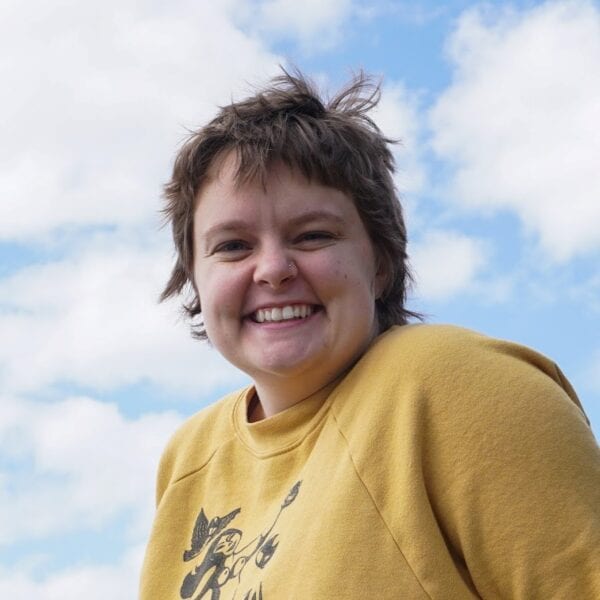It’s almost the end of coho season, on a sunny and cloudless day unusual for mid-September. Our ride for the next four hours, the Proud Mary, is a custom-built aluminum boat that fits six. Today, there are only five of us onboard: four passengers with varying levels of experience and Morgan, our captain with Alaska Adventures Unlimited.
I should be honest here: it’s my first time fishing. Technically speaking, I did go ice fishing once as a seven-year-old. But after thirty minutes of nose-biting cold and not a single nibble on the line, I packed up my pole and slept in the car.
Now that I’m on a charter fishing boat for the first time, I have no idea what to expect. I mentally run through late night reruns of Deadliest Catch, but wait a minute – weren’t they fishing for crab anyways? In the Bering Sea? Maybe I’m even less prepared than I thought I was.
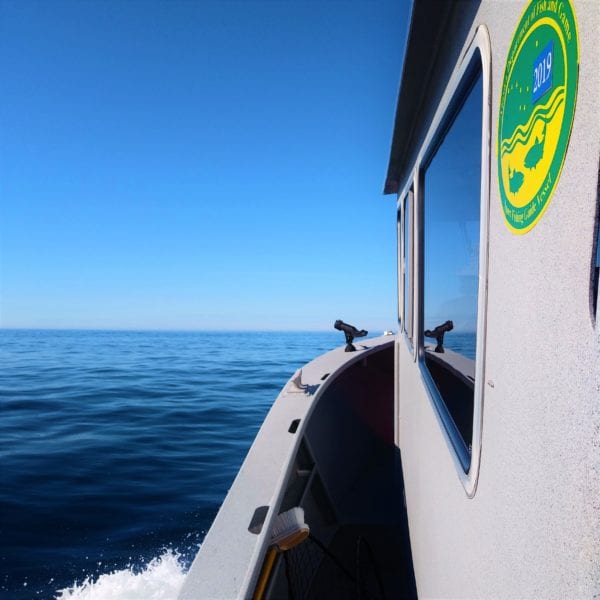
The Proud Mary cruises towards open waters
Morgan outlines our trip for us: it will take the Proud Mary one hour to reach the Gulf of Alaska, where we’ll troll for coho salmon (also known as silver salmon) on the open water. Unlike the black-gummed Chinook, or King salmon, coho are distinctive for their pale white gums. In saltwater, their scales are a bright silver, with dark, metallic spots on their backs and tails.
As we travel through Sitka Sound, Morgan points out landmarks like St. Lazaria Island, where we stop to watch a common murre colony nesting in a cave. Even before we see them, we can hear their voices echoing, loud and raucous, across the water.
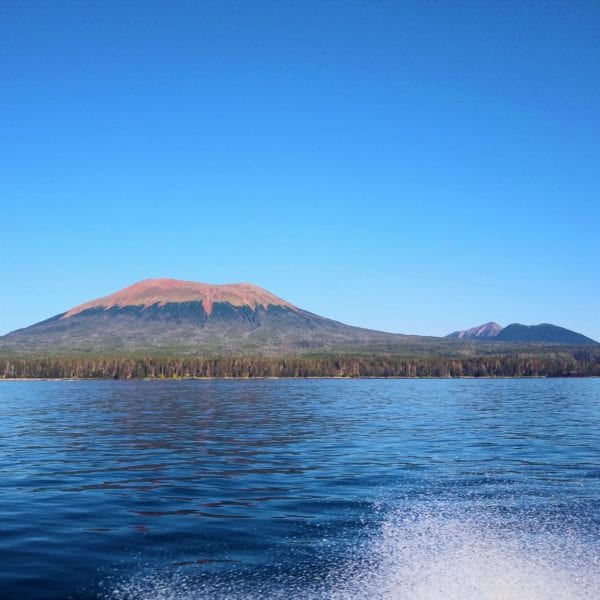
Mt. Edgecumbe from the deck
One of the passengers, however, is more curious about the looming Mount Edgecumbe.
“Is it active?” they ask.
Morgan shakes his head.
“No, but did you hear about the famous April Fools prank?”
Long before I could point to Sitka on a map, I’d heard of Olivar “Porky” Bickar and his legendary prank. In the spring of 1974, he flew hundreds of old car tires up to the volcano’s rim via helicopter and burned them. Thousands of Sitkans watching the cloud of black, acrid smoke from town were convinced that Mount Edgecumbe was erupting.
Looking at Mount Edgecumbe now, there’s a single tendril of low-hanging cloud that I can almost pretend is smoke.
It’s a windy day, and the waves get choppier once we reach the gulf; a sheet of fine white spray hits the windows as we dip lazily into each swell. On the Proud Mary’s monitoring screens, Morgan watches his previous routes mapped onto the water in overlapping loops and swirls.
There are dozens of boats on the water today: commercial trollers and charter boats like this one. Sometimes, we pass close enough to give a friendly wave.
Once he’s chosen a spot, Morgan sets up two fishing rods on the deck, one on each side of the boat, and connects the lines to downriggers that plunge the bait deep below the surface. Salmon swimming at that depth will see the flasher, a strip of winking, reflective plastic, and hopefully grab the lure.
The first ten minutes of fishing are a flurry of activity; Morgan has barely finished giving instructions when there’s a bite on the port side. Another passenger grabs the rod and takes over.
Almost immediately, there’s a bite on the starboard side, and it’s my turn.
My hands shake with adrenaline as I push the rod out of its holder and brace it against my hip. I’m surprised by the salmon’s weight and resistance as it struggles on the other end of the line, and I can hardly hear the other passengers’ shouts of encouragement over the sound of the blood rushing in my ears.
The flasher winks beneath the surface, and as it crests over a wave, I finally see my catch: the coho thrashing wildly behind. The moment it’s within arm’s reach, Morgan scoops it out of the water with the net.
“That’s a beautiful fish,” a passenger whistles, as it hits the deck with a smack. Morgan resets the lines.
A third fish bites but breaks free. Then, nothing.
Fishing, I soon learn, is an unpredictable and meditative activity. The first ten minutes of action are followed by an hour and fifty minutes of intermittent waiting and movement, as we try to lure more fish.
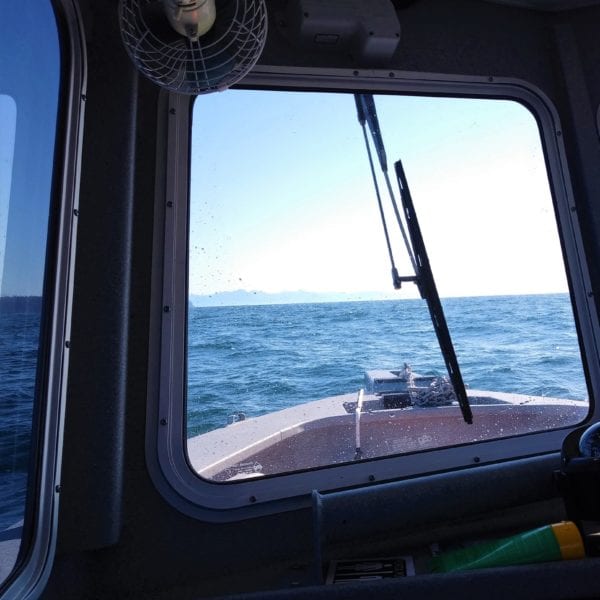
Circling for a catch
Motion sickness, I also learn, is much worse on an empty stomach. Luckily or unluckily, I’m the only one affected. The Operations Manager of Alaska Adventures Unlimited, Samantha Obitz, has packed us each our own snack bags; they’re filled with organic fruit chews, granola bars, and colorful saltwater taffy. I open mine, and Morgan offers a bottle of water or Sprite from the cooler.
“Looking at the horizon helps,” he says.
He’s right.
We circle through the water and eventually return to the site of our first two catches. Nothing bites, but Morgan resets the lines several times, just in case.
“Are you keeping or taking?” he eventually asks.
“Sorry?”
“Do you want to keep your fish?”
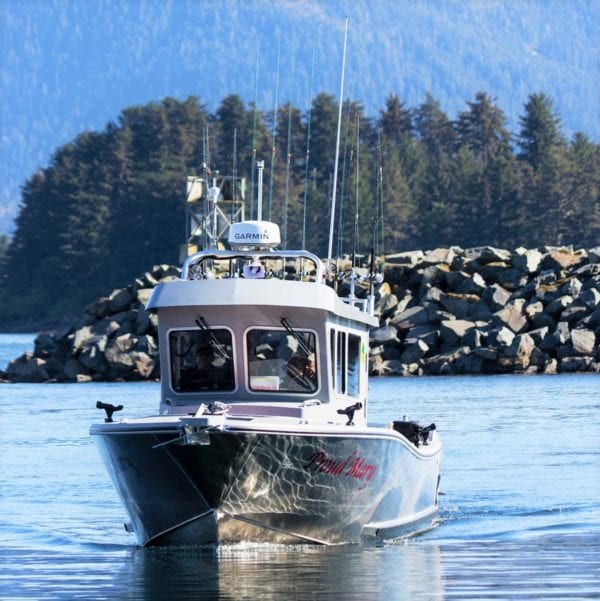
The Proud Mary heading back to Sitka. Picture courtesy of Alaska Adventures Unlimited.
I have no idea what to do with a dead fish; I imagine carrying it through the streets of Sitka and trying to gut it in my kitchen.
“Yes,” I answer, before I can think about it too much. Fortunately, Morgan cleans our fish and guts them himself.
Eventually, our time is up. Some days are like that, a more experienced passenger tells me. A woman visiting from Canada is disappointed; she never got a bite. As she helps Morgan reel in the line, however, she’s delighted to see a small fish caught on the other end.
Can I say I caught a coho salmon?” she asks, after Morgan releases it.
“You did catch a coho salmon, just a young one,” he tells her.
She beams. After that, every once in a while, I can see her mouth “I caught a salmon” giddily to herself. As we head back towards Sitka, the same passenger spots a whale breaching on the horizon, and the rest of us just miss it. She and Morgan debate whether it was a humpback or an orca.
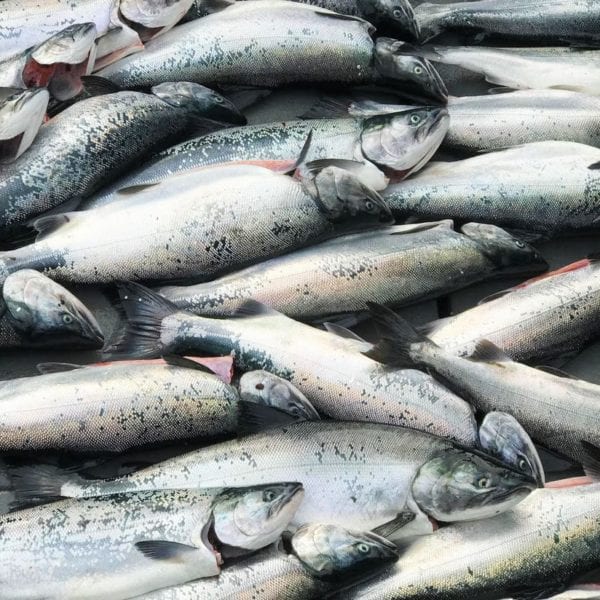
A sizeable catch. Picture courtesy of Alaska Adventures Unlimited.
At Crescent Harbor, we’re met by several staff members who have joined us to figure out logistics. The other fish will be sent to a processing facility, where it will be filleted, vacuum sealed, flash frozen, and express mailed on a box of ice to a house in New Jersey. Meanwhile, someone finds an oversized plastic bag for my fish, and Morgan shows me where I will have to make the cuts along the spine.
For the record, carrying a dead fish home through the streets of Sitka feels exactly the way I imagined it would, but better. After an hour of consulting Youtube videos and Google, my roommates and I manage to cut enough delicious, but slightly ragged-looking, fillets to feed all of us for several meals. We experiment with different recipes, spices, and glazes, oven baking some and pan-searing others.
The taste of lemon, garlic, and fresh wild-caught fish lingers in my mouth for days.
